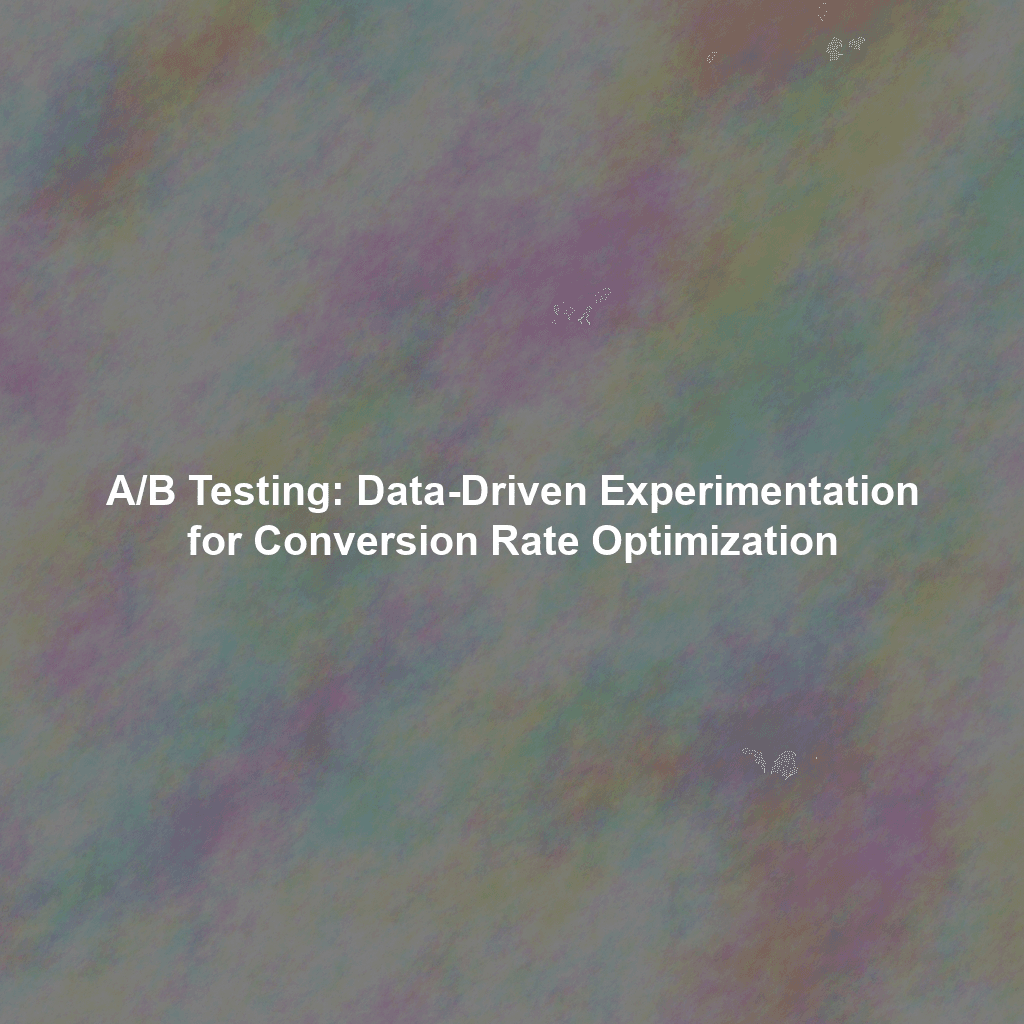Understanding A/B Testing: The Foundation of Data-Driven Decisions
In the ever-evolving landscape of digital marketing, guesswork simply doesn’t cut it. To truly understand what resonates with your audience and drives conversions, you need a rigorous, data-driven approach. That’s where A/B testing, also known as split testing, comes in. It’s not just a tool; it’s a mindset, a philosophy of continuous improvement based on evidence, not intuition.
At its core, A/B testing is a simple yet powerful method for comparing two versions of a single variable – be it a website headline, a call-to-action button, or even an entire landing page – to determine which performs better. By randomly showing each version (A and B) to different segments of your audience and meticulously tracking the results, you can identify the variant that leads to the highest conversion rate. This conversion rate, whether it’s form submissions, sales, or sign-ups, becomes the north star guiding your optimization efforts.
The Significance of Data in Marketing
Imagine navigating a ship without a compass – you’re essentially adrift at sea, relying on luck and gut feelings. In today’s digital arena, data serves as your compass, guiding you toward success. Marketing analytics provides the insights needed to understand customer behavior, identify trends, and optimize your campaigns. A/B testing fits perfectly within this framework by turning hunches into testable hypotheses and providing concrete data to validate or invalidate them.
Without data, you’re operating in the dark, making decisions based on assumptions that may or may not be accurate. A/B testing, however, illuminates the path forward, revealing what truly drives user engagement and conversions. This data-centric approach minimizes risks and maximizes returns on your marketing investments.
The A/B Testing Process: A Step-by-Step Guide
While the concept of A/B testing is straightforward, executing it effectively requires a structured approach. Here’s a breakdown of the key steps involved:
1. Define Your Objective and Hypothesis
Every A/B test should start with a clearly defined objective. What do you want to achieve? Do you want to increase sign-ups, improve click-through rates, or boost sales? Once you have a goal in mind, formulate a hypothesis – a testable statement about what you believe will happen when you change a specific element. For example: “Changing the headline on our landing page from ‘Get Your Free Trial’ to ‘Start Your Journey Today’ will increase sign-ups by 10%.”
A strong hypothesis includes:
- The variable you’re testing (e.g., headline).
- The change you’re making (e.g., from ‘Get Your Free Trial’ to ‘Start Your Journey Today’).
- The expected outcome (e.g., increase sign-ups by 10%).
2. Identify the Variable to Test
What element of your website or marketing material will you modify? This could be anything from the color of a button to the length of a paragraph. It’s crucial to focus on one variable at a time to isolate its impact on the outcome. Testing multiple variables simultaneously makes it difficult to determine which change is responsible for the results.
Common variables to test include:
- Headlines
- Call-to-action (CTA) buttons (text, color, size)
- Images and videos
- Form fields
- Website layout
- Pricing structure
- Email subject lines
3. Create Your Variations (A and B)
Based on your hypothesis, create two versions of the element you’re testing: the control (A) and the variation (B). The control is the existing version, while the variation is the modified version you believe will perform better. Ensure that the only difference between the two versions is the variable you’re testing. This helps maintain the integrity of the experiment and accurately measure the impact of the change.
4. Implement Your A/B Test
Now it’s time to implement your A/B test using a testing platform or tool. These platforms automatically split your audience into two groups, showing version A to one group and version B to the other. Ensure the traffic is split randomly and evenly to avoid bias. Popular A/B testing tools include Google Optimize, Optimizely, VWO, and Adobe Target. These tools often provide features like statistical significance calculations and reporting.
5. Run the Test and Collect Data
Let your A/B test run for a sufficient amount of time to gather enough data to reach statistical significance. The duration of the test depends on your traffic volume and the magnitude of the difference between the two versions. Monitor the results closely, but avoid making premature conclusions. It’s important to allow the test to run its course to account for natural variations in user behavior.
6. Analyze the Results and Draw Conclusions
Once the test has concluded, analyze the data to determine which version performed better. Pay attention to the key metrics you defined in your objective. Was there a statistically significant difference between the two versions? If so, which version led to a higher conversion rate? Statistical significance indicates that the observed difference is unlikely to be due to random chance, providing confidence in your results.
7. Implement the Winning Variation
If one version outperformed the other with statistical significance, implement the winning variation on your website or marketing material. This is where you reap the benefits of your data-driven experimentation.
8. Iterate and Repeat
A/B testing is not a one-time activity; it’s an ongoing process of continuous improvement. Use the insights gained from each test to inform future experiments. What did you learn about your audience’s preferences? What other variables could you test to further optimize your conversion rates? The cycle of hypothesizing, testing, and analyzing should become an integral part of your marketing strategy.
Statistical Significance: Understanding the Numbers
A crucial aspect of A/B testing is understanding statistical significance. This concept helps you determine whether the observed difference between two variations is a real effect or simply due to random chance.
What is Statistical Significance?
Statistical significance is a measure of confidence that the difference between two groups is not due to random variation. It’s typically expressed as a p-value, which represents the probability of observing the results you did if there was no real difference between the groups. A p-value of 0.05 or less is generally considered statistically significant, meaning there’s a 5% or less chance that the observed difference is due to random chance.
Why is it Important?
Without statistical significance, you can’t be confident that the winning variation is truly better than the control. You might be implementing changes based on random fluctuations, which could actually hurt your conversion rates in the long run. Ensuring statistical significance provides a solid foundation for your optimization efforts.
Factors Affecting Statistical Significance
Several factors can influence statistical significance, including:
- Sample Size: The larger the sample size (number of users exposed to each variation), the more likely you are to detect a statistically significant difference.
- Effect Size: The larger the difference between the two variations, the easier it is to achieve statistical significance. A small difference requires a larger sample size to be detected.
- Baseline Conversion Rate: The higher the baseline conversion rate, the easier it is to detect a statistically significant improvement.
Common A/B Testing Mistakes to Avoid
Even with a solid understanding of A/B testing principles, it’s easy to fall into common pitfalls. Here are some mistakes to avoid:
1. Testing Too Many Variables at Once
As mentioned earlier, testing multiple variables simultaneously makes it difficult to isolate the impact of each change. Focus on testing one variable at a time to get clear, actionable results.
2. Stopping the Test Too Early
Prematurely ending a test can lead to inaccurate conclusions. Allow the test to run for a sufficient amount of time to account for natural variations in user behavior and reach statistical significance.
3. Ignoring Statistical Significance
Implementing changes based on results that are not statistically significant can be risky. Always ensure that the observed difference is not due to random chance before making decisions.
4. Not Segmenting Your Audience
Analyzing your results in aggregate can mask important differences between different segments of your audience. Consider segmenting your audience based on demographics, behavior, or traffic source to gain deeper insights.
5. Failing to Document Your Experiments
Keep a detailed record of each A/B test you run, including the objective, hypothesis, variables tested, results, and conclusions. This documentation will serve as a valuable resource for future optimization efforts.
6. Lack of a Clear Hypothesis
Jumping into A/B testing without a clearly defined hypothesis is like shooting in the dark. You need a specific, testable statement to guide your experiment and ensure you’re measuring meaningful results. A weak or non-existent hypothesis renders the entire process aimless and makes it difficult to draw actionable conclusions.
The Power of Continuous Optimization
A/B testing isn’t just about finding a winning variation; it’s about creating a culture of continuous optimization within your marketing team. By embracing a data-driven approach and consistently testing new ideas, you can continuously improve your conversion rates and achieve your business goals.
Think of A/B testing as an investment. Each test you run provides valuable insights into your audience’s preferences, allowing you to make more informed decisions in the future. Over time, these incremental improvements can add up to significant gains.
Conclusion: A/B Testing as a Cornerstone of Marketing Analytics
A/B testing is an indispensable tool for any marketer seeking to optimize their campaigns and achieve sustainable growth. By embracing a data-driven approach and continuously testing new ideas, you can unlock the full potential of your marketing efforts and create experiences that resonate with your audience. Remember, it’s not about guessing what works; it’s about using data to prove what works and continuously striving for improvement. Make A/B testing a cornerstone of your marketing analytics strategy, and you’ll be well on your way to achieving your business objectives.
 Skip to content
Skip to content

